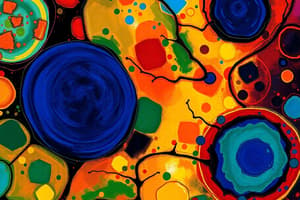Podcast
Questions and Answers
What is the active form of IL-1α?
What is the active form of IL-1α?
Pro IL-1α when present in membrane bound form
What cytokine is secreted by macrophages and dendritic cells that has functions similar to IL-1?
What cytokine is secreted by macrophages and dendritic cells that has functions similar to IL-1?
IL-18
Which TH2 cytokines does IL-33 induce?
Which TH2 cytokines does IL-33 induce?
TH2 cytokines
What is a defining feature of the Hematopoietin (Class I) family of cytokines?
What is a defining feature of the Hematopoietin (Class I) family of cytokines?
Which type of cells secrete Type I Interferon?
Which type of cells secrete Type I Interferon?
What is IFN-γ and what is its role?
What is IFN-γ and what is its role?
What is the function of TNF family cytokines?
What is the function of TNF family cytokines?
Which cytokine is primarily secreted by activated macrophages?
Which cytokine is primarily secreted by activated macrophages?
The membrane attack complex (MAC) facilitates free flow of small molecules and ions, compromising the __________ integrity.
The membrane attack complex (MAC) facilitates free flow of small molecules and ions, compromising the __________ integrity.
What is the role of C3a and C5a in inflammation?
What is the role of C3a and C5a in inflammation?
What type of receptors do C3a and C5a bind to?
What type of receptors do C3a and C5a bind to?
What are stem cells?
What are stem cells?
What is an embryonic stem cell?
What is an embryonic stem cell?
What is hematopoiesis?
What is hematopoiesis?
Which types of blood cells do hematopoietic stem cells (HSCs) differentiate into?
Which types of blood cells do hematopoietic stem cells (HSCs) differentiate into?
Basophils play a role in allergic reactions.
Basophils play a role in allergic reactions.
What is the lifespan of neutrophils?
What is the lifespan of neutrophils?
What do macrophages do?
What do macrophages do?
The site of maturation for B-lymphocytes is _____ in mammals.
The site of maturation for B-lymphocytes is _____ in mammals.
Which type of T lymphocyte is responsible for inhibiting immune responses?
Which type of T lymphocyte is responsible for inhibiting immune responses?
What is the function of Natural Killer (NK) cells?
What is the function of Natural Killer (NK) cells?
Toll-like receptors (TLRs) are a type of pattern recognition receptor.
Toll-like receptors (TLRs) are a type of pattern recognition receptor.
What is the role of cytokines?
What is the role of cytokines?
What type of cells can differentiate into all types of blood cells?
What type of cells can differentiate into all types of blood cells?
What infections do eosinophils respond to?
What infections do eosinophils respond to?
Flashcards are hidden until you start studying
Study Notes
Stem Cells Overview
- Stem cells possess the ability to self-renew and differentiate into various cell types.
Types of Stem Cells
- Embryonic Stem Cells: Pluripotent cells capable of generating all cell types in an organism.
- Adult Stem Cells: Found in specific organs, these cells can only differentiate into cell types of the particular tissue. Key examples include:
- Hematopoietic Stem Cells (HSC): Found in bone marrow; differentiate into all blood cell types.
- Mesenchymal Stem Cells (MSC): Also present in bone marrow; can differentiate into various connective tissue types.
Hematopoietic Stem Cells (HSC)
- Present in less than 1 in 500,000 bone marrow cells.
- Generally quiescent but can rapidly proliferate in response to need.
- Hematopoiesis: The process by which HSCs develop into different blood cell types, influenced by environmental factors.
Types of Blood Cells
- Common Myeloid Progenitors (CMP) lead to:
- Erythroid Progenitors that become erythrocytes (red blood cells) and platelets.
- Differentiate into myeloid lineage cells including granulocytes and myeloid antigen-presenting cells.
Granulocytes
- Neutrophils: Short lifespan, primary responders to infection, increase during infection (leukocytosis). Utilize phagocytosis and release antimicrobial proteins.
- Basophils: Contain granules with histamine; play a role in allergic reactions and inflammation.
- Mast Cells: Found in various tissues, performing functions similar to basophils.
- Eosinophils: Involved in defense against multicellular organisms; linked to asthma and allergies.
Myeloid Antigen-Presenting Cells
- Monocytes: Differentiate into tissue-resident phagocytic cells; includes inflammatory and patrolling subtypes.
- Macrophages: Key players in tissue repair, regeneration, and pathogen engulfment.
- Dendritic Cells: Important for T-cell activation; can arise from both myeloid and lymphoid lineages.
Lymphoid Lineage Cells
- Lymphocytes: Essential for adaptive immunity, make up 20-40% of circulating blood lymphocytes.
- Types include B cells, T cells, and Natural Killer (NK) cells, distinguished by surface proteins (CD markers).
B-Lymphocytes
- Mature in bone marrow; differentiate into plasma cells (antibody-secreting) and memory cells.
T-Lymphocytes
- Mature in the thymus; express T cell receptors (TCRs) and include:
- T-cytotoxic Cells: Identify and eliminate infected or cancerous cells (CD8+).
- T-helper Cells: Provide help in immune responses (CD4+), further subclassified into TH1, TH2, TH17, and T follicular helper cells.
- T Regulatory Cells: Regulate immune responses to maintain homeostasis.
Natural Killer (NK) Cells
- Part of innate immunity, recognized for their ability to kill abnormal cells without antigen specificity.
Innate Immunity Overview
- Involves physical barriers (skin, epithelial layers), chemical barriers (antimicrobial peptides), and cellular responses (phagocytosis, inflammation).
Pattern Recognition Receptors
- PAMPs & DAMPs: Recognized by PRRs, important for initiating immune responses against pathogens and damaged cells.
Opsonins
- Soluble proteins that enhance phagocytosis by binding to microbial surfaces (e.g., Collectins, MBL, CRP).
Phagocytosis
- Involves engulfing pathogens into phagosomes that fuse with lysosomes, forming phagolysosomes containing antimicrobial agents.
Toll-Like Receptors (TLRs)
- First identified PRRs; crucial for recognizing pathogens and triggering immune responses.
- Signal transduction via various adaptor proteins (e.g., MyD88, TRIF) leading to immune activation (e.g., NF-κB pathway).
Cytokines and Chemokines
- Cytokines: Small proteins acting as immune system messengers, influencing cell behavior.
- Chemokines: Specific cytokines that attract immune cells for effective immune response.
Cytokine Families
- Interleukin 1 Family: Early response cytokines; enhance leukocyte migration and activate other immune cells.
- Hematopoietin (Class I): Involved in T and B cell proliferation and differentiation.
- Interferon (Class II): Plays roles in antiviral response and immune modulation.
- Tumor Necrosis Factor (TNF) Family: Regulate immune development and responses, critical for inflammation and cell death mechanisms.
Primary and Secondary Lymphoid Organs
- Primary: Bone marrow and thymus where immune cells develop from precursors.
- Secondary: Lymph nodes, spleen, MALT where mature lymphocytes respond to specific antigens.
Additional Organ Functions
- Skin: First line of defense containing immune cells.
- Liver: Engaged in filtering blood and producing immune factors.### TNF-β and Cytokines
- TNF-β (Lymphotoxin-α) is primarily produced by activated lymphocytes.
- It activates neutrophils, endothelial cells, and osteoclasts, and enhances expression of MHC glycoproteins and adhesion molecules in various cells.
- TNF-family cytokines form trimers (homotrimers and heterotrimers) with a conserved tertiary structure.
- Interleukin-17 (IL-17) family consists of proinflammatory cytokines with receptors on neutrophils and keratinocytes, predominantly acting as homodimers.
Chemokines
- Chemokines are small cytokines (7.5-12.5 kDa) inducing leukocyte movement via chemotaxis.
- They are classified into six categories based on cysteine residue presence, with high sequence identity within categories.
- ELR (glutamic acid-leucine-arginine) chemokines attract neutrophils and promote angiogenesis via CXCR2 receptor.
- Non-ELR chemokines use CXCR4 receptor and are angiostatic, while 4C CC and 6C CC chemokines attract monocytes and macrophages.
Complement System
- Complement system, described by Paul Ehrlich, enhances antibody action, consisting of around 30 glycoproteins and accounting for about 15% of plasma globulin.
- Most components are synthesized in the liver; some are produced by other cell types.
- Seven categories of complement components: initiators, enzymatic mediators, opsonins, inflammatory mediators, membrane attack complex (MAC), complement receptors, and regulatory components.
Complement Activation Pathways
- Classical pathway initiates with C1 complex (C1qr2s2), binding to Fc sites of antibodies for activation.
- Lectin pathway involves Mannose Binding Lectin (MBL) and associated serine proteases (MASP).
- Alternative pathway activated by protein factors involved in blood clotting, cleaving C3 and C5.
Membrane Attack Complex (MAC)
- MAC formation begins with C5b binding to C6 and C7, inducing conformational changes and exposing hydrophobic regions.
- C8, composed of two polypeptide chains, interacts with C5b67, with C8αγ inserting into the phospholipid bilayer.
- Binding of C9 molecules results in pore formation (70-100 Angstroms) that compromises membrane integrity, leading to cell lysis or apoptosis.
- Gram-positive bacteria resist complement due to their cell wall structure, preventing complement protein penetration.
Opsonization and Inflammation
- C3a and C5a, 9 kDa proteins, act as anaphylatoxins promoting inflammation and chemoattraction of leukocytes.
- They bind to G-protein coupled receptors, triggering cytokine secretion like IL-6 and TNF-α.
- Facilitate phagocytosis of pathogens by dendritic cells and degranulation of granulocytes.
Studying That Suits You
Use AI to generate personalized quizzes and flashcards to suit your learning preferences.



